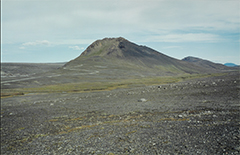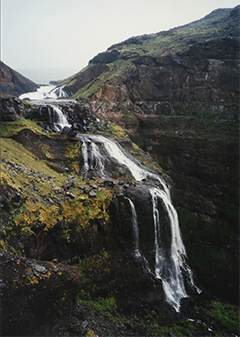Light, Water, Ice and Stone: Eliasson's Play with the Elements





Light. Water. Ice. Stone. These are the very foundational elements that are rolled out in the Danish-Icelandic artist Olafur Eliasson's world-famous art installations and in his photographs. Eliasson's photographs of the wild Icelandic nature have been exhibited in art museums all over the world, published in books and sold at high prices on the art market. And there is good reason for this, because right from the beginning of Eliasson's career, the photographs have functioned as studies for his magnificent installations, and therefore they provide a special insight into Eliasson's relationship with the Icelandic nature from which the installations originate.
View all Olafur Eliasson's photographs at auction here
Capturing Nature
Eliasson has photographed the magnificent Icelandic nature during annual walks around the country. In the pictures, he reveals key elements that are also a large part of his installations – from systematic depictions of waterfalls, trails in the landscape, icebergs and volcanic craters to more classically artistic panoramic views and landscape images. Capturing the grand encounter with nature is attempted. By the artist. But why photograph waterfall upon waterfall and glacier ravine upon glacier ravine? How do they differ from ordinary landscape photographs, like the ones we take on a vacation? And how do they contribute to his art installations?
The Famous Installations
Eliasson is famous for the impressive light installation "The Weather Project" at Tate Modern in London, as well as having waterfalls fall from bridges around New York and letting icebergs melt in front of the Louvre Museum in Paris. In Denmark, most people know his rainbow-coloured glass walkway "Your rainbow panorama" at the top of the ARoS Art Museum in Aarhus, where you can see the view of Aarhus change according to all the different colours of the rainbow. Many also became acquainted with his landscape installation at the Louisiana Museum of Modern Art a couple of years ago. Here, a large part of the museum was transformed into a barren stone landscape with tiny trickling brooks – all of it indoors, mind you.
Interaction and Opposition
The meeting between nature and culture – in interaction and opposition – runs as a thread through Olafur Eliasson's work. Just like the experience of being part of something bigger – or smaller so to speak. Eliasson's work underlines the fact that we cannot separate ourselves from our senses or from nature. We can theorize and view nature scientifically, historically or through art history, but when nature is suddenly invited inside or one stands in the middle of a rainbow and looks out over Aarhus in shades of purple, blue or green, we become aware that we are our senses. And as a small ironic twist, Eliasson lets the audience experience this meeting with the magnificent power of nature in the heart of high culture – at art museums around the world.
Fundamental Photographic Research
So, even though Eliasson is most famous for his magnificent installations today, his photographs are a form of "fundamental research" in his artistic work and have been part of his work method, since he attended the Royal Danish Academy of Fine Arts in the early 1990s. This has resulted in a long, famous series of unique photographs called the Iceland series: different landscape photographs from Iceland, often with traces of a human presence. In addition, he has produced a large number of composite works consisting of many individual parts, which together constitute a larger work, e.g. the series “The Hydraulicpowerstation Series”, which is offered at the auction on 21 November.
A High Degree of Climate Awareness
The photographs are a solid documentation of Eliasson's own personally experienced view and meeting with the grandeur of nature. However, the serial form that both documents the individual waterhole or iceberg and the many varieties of waterholes and icebergs also points to a more universal duality: Nature is both infinitely varied, yet it can be systematized and cultivated.
In light of the climate crisis, natural disasters and discussions of fact and fiction in regard to pollution and CO2 emissions, Eliasson's artwork – both the installations and the photographs – is still highly topical. The artwork reminds us that we will always be just a small part of a much larger (eco) system. If we choose to place ourselves on the sidelines and think we can only observe and theorize from a distance, then we will most likely be in for quite the experience at some point, because that is how nature works.
View all the photographs at auction here
Preview and Auction
In addition to the works by Olafur Eliasson, we also present a large number of other photo-based contemporary artworks by Danish artists, vintage photographs and documentary photo collections from places such as China, Syria, Egypt, Norway, Japan, including a Japanese emperor couple in original silver frame and box. All the photographs can be viewed at the preview in our department at Baltikavej 10 in Copenhagen's Nordhavn on 20 and 21 November between 10 am and 5 pm. The auction itself is currently up and running on Bruun-rasmussen.dk and will begin to end on 21 November from 6 pm.
We hope to see you at the preview or online!
For further information, please contact:
Christine Almlund: +45 8818 1216 · cal@bruun-rasmussen.dk